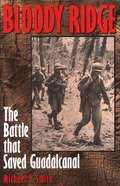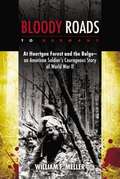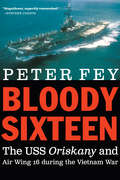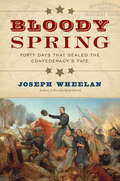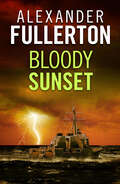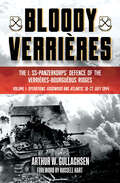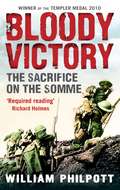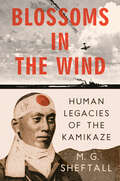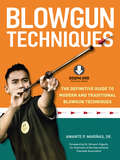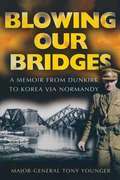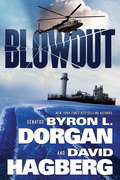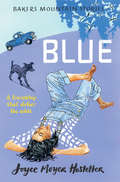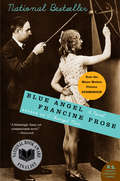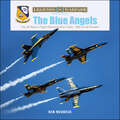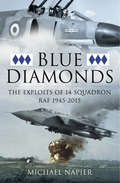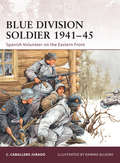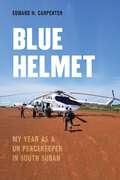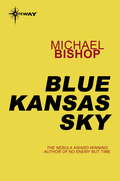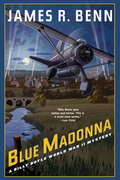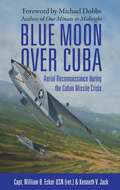- Table View
- List View
Bloody Ridge: The Battle That Saved Guadalcanal
by Michael S. SmithThe battle for Guadalcanal and the defense of Bloody Ridge by Lt. Col. "Red Mike" Edson's Marine Raiders and the attached remnants of the 1st Parachute Battalion are recounted. Photos and maps.
Bloody Roads to Germany
by William F. MellerHe never planned on becoming a leader--or a hero . . . In early October of 1944 Private William Meller was 20 years old. Joining I Company, 28th Divison as a rifleman, he was indoctrinated on the front line to the horrors of fighting the battle-hardened German Wehrmacht in the wet freezing cold of the Huertgen Forest. In early November, fighting with only rifles and grenades for three days and without food, water or medical supplies two hundred men of I Company were surrounded, killed, wounded or captured. This created the only Cease Fire in WWII. Meller and two GIs escaped to the American lines with the guidance of a German Corporal. In early November I Company was re-formed, with Meller as Sergeant-squad leader, second Platoon and moved to the Ardennes; installed their Outpost one half mile facing the Siegfried Line on the German-Luxembourg border next to Walthausen. At 6:30 AM December 16 the Panzer Lehr German Division crossed the Our River: With Staff Sergeant Meller, now the Platoon Leader, 12 men stopped the German Armored Infantry offensive until they ran out of ammunition and the Panther Tanks arrived at 4:30 PM. This was beginning of The Battle of the Bulge. INCLUDES PHOTOS
Bloody Sixteen: The USS Oriskany and Air Wing 16 during the Vietnam War
by Peter FeyStrategy and reality collide in Peter Fey’s gripping history of aircraft carrier USS Oriskany’s three deployments to Vietnam with Carrier Air Wing 16 (CVW-16). Its tours coincided with the most dangerous phases of Operation Rolling Thunder, the ill-fated bombing campaign against North Vietnam, and accounted for a quarter of all the naval aircraft lost during Rolling Thunder—the highest loss rate of any carrier air wing during Vietnam. The Johnson administration’s policy of gradually applied force meant that Oriskany arrived on station just as previous restrictions were lifted and bombing raids increased. As a result CVW-16 pilots paid a heavy price as they ventured into areas previously designated “off limits” by Washington DC. Named after one of the bloodiest battles of the Revolutionary War, the Oriskany lived up to its name. After two years of suffering heavy losses, the ship caught fire—a devastating blow given the limited number of carriers deployed. With only three months allotted for repairs, Oriskany deployed a third and final time and ultimately lost more than half of its aircraft and more than a third of its pilots. The valor and battle accomplishments displayed by Oriskany’s aviators are legendary, but the story of their service has been lost in the disastrous fray of the war itself. Fey portrays the Oriskany and its heroes in an indelible memorial to the fallen of CVW-16 in hopes that the lessons learned from such strategic disasters are not forgotten in today’s sphere of war-bent politics.
Bloody Spring: Forty Days that Sealed the Confederacy's Fate
by Joseph WheelanIn the spring of 1864, Robert E. Lee faced a new adversary: Lieutenant General Ulysses S. Grant. Named commander of all Union armies in March, Grant quickly went on the offensive against Lee in Virginia. On May 4, Grant's army struck hard across the Rapidan River into north-central Virginia, with Lee's army contesting every mile. They fought for forty days until, finally, the Union army crossed the James River and began the siege of Petersburg.The campaign cost 90,000 men-the largest loss the war had seen. While Grant lost nearly twice as many men as Lee did, he could replace them. Lee could not and would never again mount another major offensive. Lee's surrender at Appomattox less than a year later was the denouement of the drama begun in those crucial forty days.
Bloody Sunset (The Russian Battles)
by Alexander FullertonA thrilling historical adventure in the shadow of the Russian Revolution.In the aftermath of the Russian Revolution, Lieutenant Bob Cowan of the British Royal Navy must rescue a party of five women, including two of the Tsar’s daughters. With the women holed up in a refuge a hundred miles up the Astrakhan river, this will be easier said than done.Astrakhan, where the Volga empties into the Caspian, was a Bolshevik stronghold, sizeable naval base and army command of half a million men. And the British Navy is here to fight Turks and Germans, not Bolsheviks. How can anyone be sure – in a climate of treachery and deception – that this isn’t some kind of a trap? Getting in there will be difficult enough, what chance will he have of getting out?With high-tension action and excellent historical detail, Bloody Sunset is ideal for fans of Douglas Reeman and Philip McCutchan.
Bloody Verrieres, Volume 1: The I. SS-Panzerkorps Defence of the Verrieres-Bourguebus Ridges—Operations Goodwood and Atlantic, 18–22 July 1944
by Arthur W. Gullachsen&“An excellent work that adds to the history of the Normandy Campaign. It also gives the armchair historian points to ponder.&” —A Wargamers Needful Things South of the Norman city of Caen, the twin features of the Verrières and Bourguebus ridges were key stepping stones for the British Second Army in late July 1944—taking them was crucial if it was to be successful in its attempt to break out of the Normandy bridgehead. To capture this vital ground, Allied forces would have to defeat arguably the strongest German armored formation in Normandy: the I. SS-Panzerkorps &“Leibstandarte.&” The resulting battles of late July and early August 1944 saw powerful German defensive counterattacks south of Caen inflict tremendous casualties, regain lost ground, and at times defeat Anglo-Canadian operations in detail. Viewed by the German leadership as militarily critical, the majority of its armored assets were deployed to dominate this excellent tank country east of the Orne river. These defeats and the experience of meeting an enemy with near-equal resources exposed a flawed Anglo-Canadian offensive tactical doctrine that was overly dependent on the supremacy of its artillery forces. Furthermore, weaknesses in Allied tank technology inhibited their armored forces from fighting a decisive armored battle, forcing Anglo-Canadian infantry and artillery forces to further rely on First World War &“Bite and Hold&” tactics, massively supported by artillery. Confronted with the full force of the Panzerwaffe, Anglo-Canadian doctrine at times floundered. In response, the Royal Artillery and Royal Canadian Artillery units pummeled the German tankers and grenadiers, but despite their best efforts, ground could not be captured by concentrated artillery fire alone. This is a detailed account of the success of I. SS-Panzerkorps&’ defensive operations, aimed at holding the Vèrrieres-Bourgebus ridges in late July 1944.
Bloody Victory: The Sacrifice on the Somme and the Making of the Twentieth Century
by William Philpott1 July 1916: the first day of the Battle of the Somme. The hot, hellish day in the fields of northern France that has dominated our perception of the First World War for just shy of a century. The shameful waste; the pointlessness of young lives lost for the sake of a few yards; the barbaric attitudes of the British leaders; the horror and ignominy of failure. All have occupied our thoughts for generations. Yet are we right to view the Somme in this way?Drawing on a vast number of sources such as letters, diaries and numerous archives, Bloody Victory describes in vivid detail the physical conditions, the combat and exceptional bravery against the odds but it also, uniquely, captures how the Somme defined the twentieth century in so many ways. This is an utterly gripping new analysis of one of the most iconic campaigns in history.
Bloody Victory: The Sacrifice on the Somme and the Making of the Twentieth Century
by William Philpott1 July 1916: the first day of the Battle of the Somme. The hot, hellish day in the fields of northern France that has dominated our perception of the First World War for just shy of a century. The shameful waste; the pointlessness of young lives lost for the sake of a few yards; the barbaric attitudes of the British leaders; the horror and ignominy of failure. All have occupied our thoughts for generations. Yet are we right to view the Somme in this way?Drawing on a vast number of sources such as letters, diaries and numerous archives, Bloody Victory describes in vivid detail the physical conditions, the combat and exceptional bravery against the odds but it also, uniquely, captures how the Somme defined the twentieth century in so many ways. This is an utterly gripping new analysis of one of the most iconic campaigns in history.
Blossoms in the Wind: Human Legacies of the Kamikaze
by M. G. SheftallA revelatory and groundbreaking account of Imperial Japan&’s kamikaze—the suicide pilots of World War II—as told through the eyes of the survivorsIn the final year of World War II, a horrific new weapon was unleashed in the Pacific: the kamikaze. Idealistic, young Japanese men had been taught that there was no greater glory than to sacrifice one&’s life to defend the homeland. Now, with the war all but lost, thousands of these determined warriors were hastily trained in the basics of piloting an airplane, then sent out in waves to crash into enemy warships, suicide attacks that killed altogether some seven thousand American sailors. But what of those men who took the sacred oath to die in battle and lived? In the wake of 9/11, ethnographer M. G. Sheftall was given unprecedented access to the cloistered community of Japan&’s last remaining kamikaze survivors. As an American fluent in Japanese, Sheftall was the only westerner to ever sit face-to-face with these men and hear their stories. The result is a fascinating journey into the lives, indoctrination, and mindsets of the kamikaze, through the eyes of participants who are now lost to time.
Blow the Man Down!: A Yankee Seaman’s Adventures Under Sail
by James H. WilliamsA weathered manuscript discovered among old papers was the foundation of this powerful book. James H. Williams’ spellbinding recollections of his adventures before the mast in sailing-ship days bring alive again that gruelling but romantic era on the seas.Though he called himself a common sailor, James H. Williams (1864-1927) was a most uncommon man. An African-American seaman with reddish hair, he left his Massachusetts home to go to sea at the age of eleven. Yet in spite of his limited formal education, he, wrote in later life with a verve and color that many professional writers would envy. Although he had once killed a man in escaping from a hell-ship at Hong Kong, Williams possessed a high sense of moral virtue. A practical man who survived countless storms and two major shipwrecks, he instinctively sought out the ships of masts and spars in an age in which the merchant marine was making its transition from sail to steam. Within him, too, burned a reforming fervor so intense that he became an uncompromising—and highly effective—enemy of all who preyed upon the common seaman.Vivid, salty, and enlivened by an unfailing sense of humor, James H. Williams’ reminiscences form a remarkable chronicle of life and adventure under sail and along the waterfronts of deep-water ports from America to China. Here are the thrill of the whale hunt and the terror of a boat’s crew as an infuriated whale capsizes them. Here are episodes of hardship and the brutality of bucko captains and mates that belied the beauty of taut, queenly ships. Here, too, are magnificent accounts of sailing ships and the stalwart men who manned them; of heroic deeds; of exotic anchorages and boisterous sprees ashore; of the immensity of the sea and its awe-inspiring gales and typhoons; of shipwreck in the English Channel on a bitter winter night; of drifting on a spar in the lonely South Atlantic and surviving for three months on an uninhabited island.
Blowback: America's Recruitment of Nazis and Its Destructive Impact on Our Domestic and Foreign Policy (Forbidden Bookshelf #2)
by Christopher SimpsonA searing account of a dark &“chapter in U.S. Cold War history . . . to help the anti-Soviet aims of American intelligence and national security agencies&” (Library Journal). Even before the final shots of World War II were fired, another war began—a cold war that pitted the United States against its former ally, the Soviet Union. As the Soviets consolidated power in Eastern Europe, the CIA scrambled to gain the upper hand against new enemies worldwide. To this end, senior officials at the CIA, National Security Council, and other elements of the emerging US national security state turned to thousands of former Nazis, Waffen Secret Service, and Nazi collaborators for propaganda, psychological warfare, and military operations. Many new recruits were clearly responsible for the deaths of countless innocents as part of Adolph Hitler&’s &“Final Solution,&” yet were whitewashed and claimed to be valuable intelligence assets. Unrepentant mass murderers were secretly accepted into the American fold, their crimes forgotten and forgiven with the willing complicity of the US government.Blowback is the first thorough, scholarly study of the US government&’s extensive recruitment of Nazis and fascist collaborators right after the war. Although others have approached the topic since, Simpson&’s book remains the essential starting point. The author demonstrates how this secret policy of collaboration only served to intensify the Cold War and has had lasting detrimental effects on the American government and society that endure to this day.
Blowgun Techniques
by Amante P. Marinas Sr. Hironori HiguchiBlowgun Techniques is a complete introduction to one of the world's oldest weapons. It provides detailed explanations and instructions on all aspects of the blowgun's use--from grips and stances, to targets and trajectories, to how to construct your own blowgun.While shooting the blowgun may seem effortless, it actually requires not only power, but also intelligence, focus and good technique. This unique combination--simplicity of design yet complexity of technique--has caused the blowgun to undergo a dramatic rise in popularity in the modern world. This popularity makes Blowgun Techniques a timely guide for hunting enthusiasts and those interested in archery-style sports competitions.
Blowing Our Bridges: A Memoir From Dunkirk To Korea Via Normandy
by Tony YoungerThis action packed military memoir tells of the exploits of a young Sapper officer during both the Second World War and in Korea. Tony Younger was in the thick of the action during the German Blitzkrieg of 1940 seeing desperate fighting as the beleaguered British Expeditionary Force struggled to escape at Dunkirk. He then became closely involved in anthrax experiments, before playing a full role in the Normandy Campaign and the conquest of Germany. After a period in Burma, he was sent to Korea, where in bitter fighting against hordes of Chinese and North Korean troops he was extremely lucky to escape with his life.
Blown to Hell: America's Deadly Betrayal of the Marshall Islanders
by Walter PincusA Pulitzer Prize–winning journalist exposes the sixty-seven US nuclear tests in the Marshall Islands that decimated a people and their land.The most important place in American nuclear history are the Marshall Islands—an idyllic Pacific paradise that served as the staging ground for over sixty US nuclear tests. It was here, from 1946 to 1958, that America perfected the weapon that preserved the peace of the post-war years. It was here—with the 1954 Castle Bravo test over Bikini Atoll—that America executed its largest nuclear detonation, a thousand times more powerful than Hiroshima. And it was here that a native people became unwilling test subjects in the first large scale study of nuclear radiation fallout when the ashes rained down on powerless villagers, contaminating the land they loved and forever changing a way of life.In Blown to Hell, Pulitzer Prize–winnng journalist Walter Pincus tells for the first time the tragic story of the Marshallese people caught in the crosshairs of American nuclear testing. From John Anjain, a local magistrate of Rongelap Atoll who loses more than most; to the radiation-exposed crew of the Japanese fishing boat the Lucky Dragon; to Dr. Robert Conard, a Navy physician who realized the dangers facing the islanders and attempted to help them; to the Washington power brokers trying to keep the unthinkable fallout from public view . . . Blown to Hell tells the human story of America’s nuclear testing program.Displaced from the only homes they had known, the native tribes that inhabited the serene Pacific atolls for millennia before they became ground zero for America’s first thermonuclear detonations returned to homes despoiled by radiation—if they were lucky enough to return at all. Others were ripped from their ancestral lands and shuttled to new islands with little regard for how the new environment supported their way of life and little acknowledgement of all they left behind. But not even the disruptive relocations allowed the islanders to escape the fallout.Praise for Blown to Hell“A shocking account of the destruction wrought by atomic bomb testing in the Marshall Islands from 1946 to 1958 . . . . Pincus makes a persuasive case that in “seeking a more powerful weapon for warfare, the U.S. unleashed death in several forms on peaceful Marshall Island people.” Readers will be appalled.” —Publishers Weekly“For more than half a century, Walter Pincus has been among our greatest reporters and most persistent truth-tellers. Blown to Hell is a story worthy of his talents—infuriating, heart-breaking, and utterly riveting.” —Rick Atkinson, Pulitzer Prize–winning author of The Liberation Trilogy
Blowout
by David Hagberg Byron L. DorganAmerica is on the brink of crisis. Unless we can curb our dangerous appetite for foreign oil, petroleum-rich countries and speculators will bring our economy to its knees. . . long before CO2 emissions will devastate our ecosystem. The President has answered the call with the Dakota District Initiative, a top secret research team hidden deep in the Badlands of North Dakota. The Initiative is developing a way to produce clean energy from coal. But powerful enemies will stop at nothing to sabotage this revolutionary technology. A cadre of oil hedge fund managers hires a crew of mercenary fanatics to attack the Initiative's experimental power station. Despite the bloody assault, the research continues as war-hero sheriff Nate Osborne and brash journalist Ashley Borden search for the attackers. The stakes couldn't be higher: Unless the Initiative succeeds we could be faced with gasoline at twenty dollars per gallon or more, putting an impossible strain on an already fragile economy. If the project fails, we will continue to poison the very air we breathe. Either way, the Badlands will run red with blood.
Blue (Bakers Mountain Stories)
by Joyce Moyer HostetterWith her father away at war to fight Hitler, a young girl gains strength by joining her community in battling polio in this Parents' Choice Silver Honor Book based on the 1944 epidemic and the "Miracle of Hickory" Hospital in Hickory, North Carolina. Ann Fay Honeycutt accepts the role of "man of the house" when her father leaves because she wants to do her part for the war. She's doing well with the extra responsibilities when a frightening polio epidemic strikes, crippling many local children. Her town of Hickory responds by creating an emergency hospital in three days. Ann Fay reads each issue of the newspaper for the latest news of the epidemic. But soon she discovers for herself just how devastating polio can be. As her challenges grow, so does her resourcefulness. In the face of tragedy, Ann Fay discovers her ability to move forward. She experiences the healing qualities of friendship and explores the depths of her own faithfulness to those she loves--even to one she never expected to love at all.
Blue Angel: A Novel
by Francine ProseThe National Book Award Finalist from acclaimed New York Times bestselling author Francine Prose—now the major motion picture Submission “Screamingly funny … Blue Angel culminates in a sexual harassment hearing that rivals the Salem witch trials.” —USA TodayIt's been years since Swenson, a professor in a New England creative writing program, has published a novel. It's been even longer since any of his students have shown promise. Enter Angela Argo, a pierced, tattooed student with a rare talent for writing. Angela is just the thing Swenson needs. And, better yet, she wants his help. But, as we all know, the road to hell is paved with good intentions.Deliciously risque, Blue Angel is a withering take on today's academic mores and a scathing tale that vividly shows what can happen when academic politics collides with political correctness.
Blue Angels: The US Navy's Flight Demonstration Team, 1946 to the Present (Legends of Warfare: Aviation #13)
by Ken NeubeckPhoto history of the US Navy Blue Angels flying-demonstration teamCovers team history from flying Hellcats, Bearcats, Cougars, Tigers, Phantoms, Skyhawks, to present-day F/A-18 HornetAlso presents graphical and photographic descriptions of some of the team's signature maneuvers
Blue By You (Military Men)
by Rachel GibsonIn her sexy new novella, Rachel Gibson, the New York Times bestselling author of Rescue Me and Run To You, once again shows that there's nothing quite like a man in uniform!They say you never forget your first time, but there's nothing Blue Butler and Kasper Pennington would rather forget than their brief but fiery teenage love affair. Yeah, it was hot while it lasted, but then he went off to join the Marines, leaving Blue in New Orleans. She's tried to block him from her mind for good, but nothing can really erase the feeling she had when she was with him.And now he's got the nerve to return—leaner, meaner, and strong enough to pull her into his arms and kiss her senseless. Blue's a successful businesswoman now, with no time to figure out what went wrong all those years ago. But Kasper knows she's the one woman for him … and now he's got to prove it to her all over again.
Blue Diamonds: The Exploits of 14 Squadron RAF, 1945–2015
by Michael NapierIn the seven decades since the Second World War, 14 Squadron has operated a wide array of aircraft types (Mosquitoes, Vampires, Venoms, Hunters, Canberras, Phantoms, Jaguars and Tornados) in a fascinating variety of roles. For much of this time, the Squadron was based in Germany at the front line of the Cold War, but it also participated in the Gulf War in 1991, in operations over Iraq from 1991-2009, in the Kosovo conflict in 2000 and latterly during the war in Afghanistan, firstly with the Tornado GR4 and then with the Shadow R1. Today the Squadron operates in great secrecy in an Intelligence, Surveillance, Target Acquisition and Reconnaissance role.Having had access to log-books, contemporary diaries, maps and photographs, as well as oral and written accounts from a large number of ex-Squadron members, the author has been able to produce as complete an account as is presently possible of the operational history of 14 Squadron in the second half of the twentieth century and the opening years of the twenty-first.
Blue Division Soldier 1941-45
by Ramiro Bujeiro Carlos JuradoOsprey's survey of the Blue Division soldiers of World War II (1939-1945). The all-volunteer 'Blue Division' was a formation that allowed Franco's technically neutral Spain to support Nazi Germany's invasion of Russia. Following initial training in Germany, the Blue Division's units were sent to the Eastern Front in August 1941, where, after a 40-day march to the front, the Division fought in several major battles including Leningrad. In 1943, with the tide turning against the Axis forces in Russia, the Division was ordered to be withdrawn, yet many men chose to stay on and serve with the Volunteer Legion. Even after the collapse in the East, some volunteered to serve with Waffen-SS units through to the fall of Berlin in 1945. This book narrates the experiences of the common soldier, exploring his motivation for serving the Wehrmacht, and detailing his dramatic experiences in a brutal and hostile theater of World War II.
Blue Helmet: My Year as a UN Peacekeeper in South Sudan
by Edward H. CarpenterBlue Helmet: My Year as a UN Peacekeeper in South Sudan tells the story of a country, a conflict, and the institution of peacekeeping through the eyes of a senior American military officer working on the ground in one of the most dangerous countries on the planet. South Sudan is rich in natural resources, and its fertile soil could make it the breadbasket of East Africa. Yet it remains the poorest and most corrupt country in the region, plagued by disease, famine, and ethnic strife. Abductions, sexual violence, death, and displacement affect tens of thousands of people each year. Edward H. Carpenter pulls readers into his world, allowing them to experience the powerful, poignant realities of being a peacekeeper in South Sudan. In the process, the author reveals how the United Nations really conducts its missions: what it tolerates and how it often falls short of achieving the aims of its charter—equal rights, justice, and economic advancement for all people—with the use of armed forces limited to serving those common interests by keeping the peace and preventing the scourge of war. It is a story that is eye-opening, unsettling, and always compelling. Global leaders may fairly claim that they have done everything they can to help South Sudan help itself: they&’ve dispatched thousands of peacekeepers and provided billions of dollars in aid. So why is the UN still struggling to fulfill its mandate to protect civilians and safeguard the delivery of humanitarian assistance? What could be done better? Bringing the reader to the forefront of action, Blue Helmet answers these questions and raises others about how modern peacekeeping missions are organized and overseen, shedding light on some of the contradictions at the heart of peacekeeping.
Blue Kansas Sky: Four Short Novels Of Memory, Magic, Surmise And Estrangement
by Michael BishopBlue Kansas Sky spans the past and future with a collection of the author's four short novels, including a coming-of-age tale set in Kansas in the late 1950s, an apartheid story from 1980s South Africa, and a twenty-first century spaceship adventure.
Blue Madonna
by James R. BennBilly Boyle, US Army detective and ex-Boston cop, faces his toughest investigation yet: infiltrating enemy lines in France as the Allies invade Normandy.It's late May 1944. Captain Billy Boyle is court-martialed on spurious charges of black market dealings. Stripped of his officer's rank, reduced to private, and sentenced to three months' hard labor, Billy is given an opportunity: he can avoid his punishment if he goes behind enemy lines to rescue a high-value Allied soldier.A secret chamber and tunnels, once used by escaping Huguenots in the 17th century, has since been taken over by the Allies. But this "safe house" on the outskirts of Chaumont turns out to be anything but--two downed airmen, one Canadian and the other American, have been murdered.Billy is flown in as part of a three-man team on June 5, 1944, the night before the Normandy invasion, and must solve the mystery of who is behind the murders before then leading a group escape back to England, with both the Germans and a killer hot on their heels.
Blue Moon over Cuba: Aerial Reconnaissance during the Cuban Missile Crisis
by Usn Ret William B. EckerMost books on the Cuban Missile Crisis tell the story using the memoirs of those who advised President Kennedy as he struggled to avoid World War III. This book is the only known personal account of the lead photographic reconnaissance squadron's scouting dangerous low-level operations, flying the supersonic RF-8A Crusader, during the classified Operation Blue Moon. Captain Ecker was the commanding officer of US Navy Light Photographic Squadron 62 (VFP-62, otherwise known as "Fightin' Photo") during the Cuban Missile Crisis, a team created for reconnaissance and aerial photography, and consulted on the movie Thirteen Days, which included dramatic scenes of his first mission over Cuba on October 23, 1962. Blue Moon over Cuba is an authoritative and complete account of the low-level reconnaissance that might be said to have helped JFK avert nuclear Armageddon.
